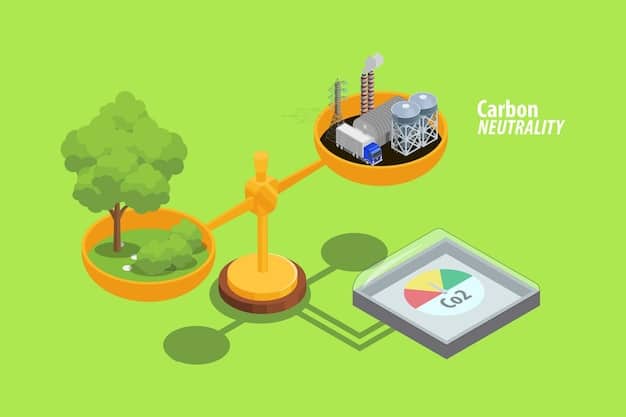Integrating Carbon Capture: How Power Plants are Adapting

Carbon capture technologies are being integrated into existing power plants through various methods, including post-combustion capture, pre-combustion capture, and oxy-fuel combustion, to reduce carbon dioxide emissions and mitigate climate change.
Existing power plants are facing increasing pressure to reduce their carbon footprint. One promising solution involves **how are carbon capture technologies being integrated into existing power plants**, offering a pathway to significantly decrease carbon dioxide emissions and contribute to a more sustainable energy future. Let’s explore the innovative methods and challenges involved in this crucial integration process.
Understanding Carbon Capture Technologies
Carbon capture technologies are essential for mitigating climate change by preventing large quantities of carbon dioxide (CO2) from entering the atmosphere. These technologies can be applied to various industrial processes, including power generation, to reduce overall emissions. Before diving into the integration methods, it’s important to understand the core principles of carbon capture.
What is Carbon Capture?
Carbon capture refers to a suite of technologies designed to capture CO2 emissions from sources like power plants and industrial facilities. The captured CO2 can then be stored permanently underground, a process known as carbon sequestration, or it can be used in various industrial applications through carbon utilization.
Different Carbon Capture Methods
There are several methods used to capture carbon dioxide, each suited to different types of facilities and processes. The most common methods include pre-combustion capture, post-combustion capture, and oxy-fuel combustion.
- Pre-Combustion Capture: This method involves converting fuel into a mixture of hydrogen and CO2 before combustion. The CO2 is then separated, and the hydrogen is used as fuel.
- Post-Combustion Capture: This method captures CO2 from the flue gas after combustion, using solvents or other materials to separate the CO2 from the other gases.
- Oxy-Fuel Combustion: This method involves burning fuel in pure oxygen instead of air, producing a flue gas that is mostly CO2 and water vapor, making it easier to capture the CO2.
Carbon capture technologies play a vital role in reducing emissions from existing power plants. The integration of these technologies is a complex process involving significant engineering and economic considerations. The choice of method depends on the specific characteristics of the power plant and the desired level of emission reduction.

Retrofitting Power Plants with Post-Combustion Capture
Post-combustion capture is a widely used method for integrating carbon capture into existing power plants. This approach is particularly attractive because it can be retrofitted to existing facilities without requiring major changes to the power generation process. The process involves capturing CO2 from the flue gas after the fuel has been burned.
The Process of Post-Combustion Capture
Post-combustion capture typically involves using chemical solvents to absorb CO2 from the flue gas. The flue gas is passed through an absorber, where the solvent selectively binds to the CO2. The solvent is then heated in a stripper, releasing the CO2, which is then compressed and transported for storage or utilization.
Challenges and Considerations
Despite its advantages, retrofitting power plants with post-combustion capture presents several challenges. These include the high energy requirements for the capture process, the cost of the solvents and equipment, and the potential environmental impacts of the solvents.
- Energy Requirements: The post-combustion capture process requires a significant amount of energy, typically in the form of heat, to regenerate the solvent.
- Cost: The cost of the solvents, equipment, and installation can be substantial, making it necessary to conduct thorough economic assessments.
- Environmental Impacts: Some solvents can have environmental impacts, such as toxicity and emissions of volatile organic compounds. It’s important to select solvents with minimal environmental impact.
Retrofitting power plants with post-combustion capture is a viable strategy for reducing carbon emissions. However, it requires careful consideration of the energy requirements, costs, and environmental impacts to ensure its effectiveness and sustainability. Ongoing research and development are focused on improving the efficiency and reducing the costs of this technology.
Implementing Pre-Combustion Capture in Power Plants
Pre-combustion capture is another method used to integrate carbon capture into existing power plants. This approach involves converting the fuel into a mixture of hydrogen and CO2 before combustion. The CO2 is then separated, and the hydrogen is used as fuel. This method is particularly suitable for integrated gasification combined cycle (IGCC) power plants.
The Process of Pre-Combustion Capture
The first step in pre-combustion capture is gasification, where the fuel (such as coal or biomass) is converted into a syngas, a mixture of carbon monoxide and hydrogen. The syngas is then reacted with steam in a water-gas shift reactor, converting the carbon monoxide into CO2 and producing more hydrogen. The CO2 is then separated, and the hydrogen is used as fuel in a gas turbine.
Advantages and Limitations
Pre-combustion capture offers several advantages over post-combustion capture, including higher CO2 capture rates and lower energy requirements. However, it also has limitations, such as the need for significant modifications to the power plant and the higher capital costs.
- Higher Capture Rates: Pre-combustion capture can achieve higher CO2 capture rates compared to post-combustion capture, typically over 90%.
- Lower Energy Requirements: The energy requirements for pre-combustion capture are generally lower than those for post-combustion capture.
- Plant Modifications: Implementing pre-combustion capture requires significant modifications to the power plant, including the installation of gasification and water-gas shift reactors.
Pre-combustion capture is a promising technology for reducing carbon emissions from power plants. While it requires significant upfront investment and plant modifications, its higher capture rates and lower energy requirements make it a viable option for certain types of power plants. Continued advancements in gasification and CO2 separation technologies are expected to further improve its efficiency and reduce its costs.
Oxy-Fuel Combustion for Carbon Capture
Oxy-fuel combustion is a third method used for integrating carbon capture into existing power plants. This method involves burning the fuel in pure oxygen instead of air, producing a flue gas that is mostly CO2 and water vapor. This simplifies the CO2 capture process, as there is no need to separate CO2 from nitrogen and other gases.
The Oxy-Fuel Combustion Process
In oxy-fuel combustion, the fuel is burned in a mixture of pure oxygen and recycled flue gas. The recycled flue gas helps to control the combustion temperature and prevent the formation of nitrogen oxides. The resulting flue gas consists mainly of CO2 and water vapor, which can be easily separated by cooling and condensation.
Benefits and Drawbacks
Oxy-fuel combustion offers several benefits, including lower energy requirements for CO2 capture and the potential for retrofitting existing power plants. However, it also has some drawbacks, such as the high cost of oxygen production and the need for specialized combustion equipment.
- Lower Energy Requirements: The energy requirements for CO2 capture in oxy-fuel combustion are lower compared to post-combustion capture, as there is no need to separate CO2 from other gases.
- Retrofitting Potential: Oxy-fuel combustion can be retrofitted to existing power plants, although it requires significant modifications to the combustion system.
- Oxygen Production Costs: The cost of producing pure oxygen is a major factor in the overall cost of oxy-fuel combustion.
Oxy-fuel combustion is a promising technology for integrating carbon capture into power plants. While it requires significant upfront investment and specialized equipment, its lower energy requirements and potential for retrofitting make it a viable option for future power plants. Ongoing research is focused on reducing the costs of oxygen production and improving the efficiency of the combustion process.

Advanced Materials and Solvents for Carbon Capture
The efficiency and cost-effectiveness of carbon capture technologies heavily rely on the materials and solvents used in the capture process. Ongoing research and development efforts are focused on developing advanced materials and solvents that can improve CO2 capture rates, reduce energy requirements, and minimize environmental impacts.
Advanced Materials
Advanced materials, such as metal-organic frameworks (MOFs) and zeolites, are being explored for their potential to selectively capture CO2 from flue gas. These materials have a high surface area and tunable pore sizes, allowing them to efficiently adsorb CO2 molecules.
Improved Solvents
Traditional solvents used in post-combustion capture, such as amines, have some limitations, including high energy requirements and potential environmental impacts. Researchers are developing improved solvents that can overcome these limitations, such as amino acid salts and ionic liquids.
- Metal-Organic Frameworks (MOFs): These materials have a high surface area and tunable pore sizes, making them effective for CO2 capture.
- Zeolites: Zeolites are crystalline materials with a well-defined pore structure, which can be tailored to selectively adsorb CO2 molecules.
- Amino Acid Salts: These solvents have lower energy requirements and are less corrosive compared to traditional amines.
- Ionic Liquids: Ionic liquids are non-volatile solvents with high thermal stability and tunable properties, making them attractive for CO2 capture.
Advanced materials and solvents are essential for improving the performance of carbon capture technologies. Continued research and development in this area are expected to lead to more efficient, cost-effective, and environmentally friendly carbon capture processes. These advancements will play a crucial role in the widespread adoption of carbon capture in existing and future power plants.
The Economics and Policy of Carbon Capture Integration
The economic feasibility and policy support play a critical role in the widespread adoption of carbon capture technologies in existing power plants. The costs associated with retrofitting power plants with carbon capture can be substantial, and policy incentives are needed to encourage investment and drive deployment.
Economic Considerations
The economics of carbon capture integration depend on several factors, including the cost of the capture technology, the price of carbon credits, and the availability of funding and incentives. The high capital costs and operating expenses associated with carbon capture can be a barrier to adoption, particularly for older power plants.
Policy and Regulatory Frameworks
Government policies and regulations can provide the necessary incentives for power plants to invest in carbon capture technologies. These policies may include carbon pricing mechanisms, tax credits, grants, and mandates for emission reductions.
- Carbon Pricing: Carbon pricing mechanisms, such as carbon taxes and cap-and-trade systems, can create a financial incentive for power plants to reduce their emissions by investing in carbon capture.
- Tax Credits and Grants: Tax credits and grants can help to offset the high capital costs associated with carbon capture, making it more economically attractive.
- Emission Reduction Mandates: Emission reduction mandates can require power plants to reduce their emissions by a certain percentage, encouraging them to adopt carbon capture technologies.
The economics and policy of carbon capture integration are crucial for driving the deployment of these technologies in existing power plants. Supportive policies and economic incentives can help to overcome the barriers to adoption and accelerate the transition to a low-carbon energy future. Collaboration between governments, industry, and research institutions is essential for developing and implementing effective policies and economic strategies.
Future Trends in Carbon Capture for Power Plants
The future of carbon capture in power plants looks promising, with ongoing research and development efforts focused on improving the efficiency, reducing the costs, and enhancing the environmental sustainability of carbon capture technologies. Several emerging trends are expected to shape the future of carbon capture in the power sector.
Integration with Renewable Energy
Integrating carbon capture with renewable energy sources, such as solar and wind, can further reduce the carbon footprint of power generation. Hybrid systems that combine carbon capture with renewable energy can provide a reliable and low-carbon source of electricity.
Carbon Utilization
Carbon utilization, also known as carbon capture and utilization (CCU), involves using captured CO2 as a feedstock for producing valuable products, such as fuels, chemicals, and building materials. This can help to offset the costs of carbon capture and create new revenue streams for power plants.
- Hybrid Systems: Combining carbon capture with renewable energy can provide a reliable and low-carbon source of electricity.
- CO2 as Feedstock: Using captured CO2 as a feedstock for producing valuable products can help to offset the costs of carbon capture and create new revenue streams.
- Direct Air Capture: Direct air capture technologies can remove CO2 directly from the atmosphere, providing a way to offset emissions from other sources.
The future of carbon capture in power plants is likely to be characterized by greater integration with renewable energy sources and a growing focus on carbon utilization. These trends will help to improve the economic feasibility and environmental sustainability of carbon capture technologies, paving the way for their widespread adoption in the power sector. Continued innovation and collaboration will be essential for realizing the full potential of carbon capture in mitigating climate change.
| Key Point | Brief Description |
|---|---|
| 💡 Post-Combustion Capture | Captures CO2 from flue gas after burning fuel, using solvents. |
| ⚙️ Pre-Combustion Capture | Converts fuel into hydrogen and CO2 before burning, separating the CO2. |
| 🔥 Oxy-Fuel Combustion | Burns fuel in pure oxygen, producing a flue gas of mostly CO2 and water. |
| 🌱 Carbon Utilization | Uses captured CO2 to produce valuable products like fuels and chemicals. |
Frequently Asked Questions
▼
The main technologies include post-combustion capture, pre-combustion capture, and oxy-fuel combustion. Each method targets CO2 at different stages of the power generation process.
▼
Carbon capture reduces greenhouse gas emissions from power plants, mitigating climate change. It allows continued use of fossil fuels while minimizing environmental impact.
▼
Challenges include high costs, energy requirements, and the need for significant infrastructure modifications. These factors can hinder widespread adoption.
▼
Carbon utilization can create new revenue streams by using captured CO2 to produce valuable products. This helps offset the costs of carbon capture technologies.
▼
Government policies such as carbon pricing, tax credits, and emission mandates can incentivize power plants to invest in carbon capture technologies and reduce emissions.
Conclusion
Integrating carbon capture technologies into existing power plants is a crucial step towards reducing greenhouse gas emissions and mitigating climate change. Various methods like post-combustion, pre-combustion, and oxy-fuel combustion offer different ways to capture CO2. Overcoming the economic and technological challenges through innovation and supportive policies is essential for a sustainable energy future.





